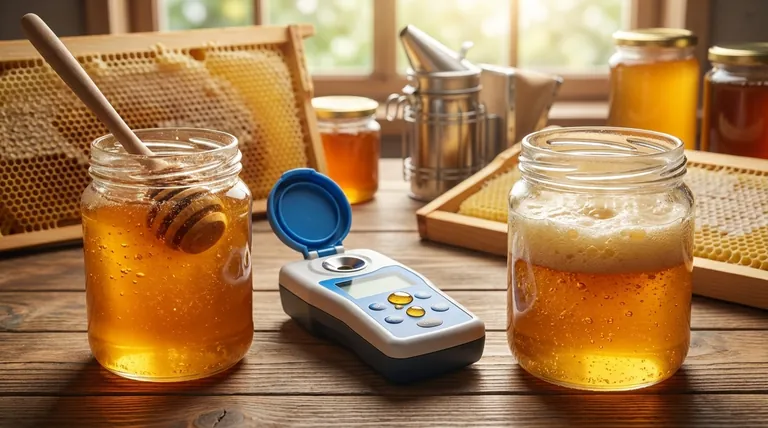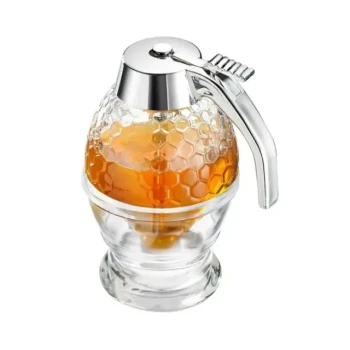While it's a common misconception, excess moisture does not cause honey to crystallize faster. In fact, it does the opposite by diluting the sugars, which can slow or even prevent crystallization. The true and far more significant danger of excess moisture is that it creates the ideal environment for yeast to grow, leading to fermentation that will spoil the honey.
The central problem with high-moisture honey is not a change in texture, but a risk of complete spoilage. While crystallization is a harmless physical process, fermentation is a biological one that permanently ruins the honey's quality, flavor, and shelf life.

The True Relationship Between Moisture and Crystallization
To understand honey quality, we must first separate the natural process of crystallization from the destructive process of fermentation. They are driven by different factors.
Why Honey Crystallizes
Honey is a supersaturated solution of sugars, primarily glucose and fructose, in a small amount of water. Crystallization occurs when glucose, which is less soluble than fructose, separates from the water and forms tiny crystals.
This process is perfectly natural and is driven by two main factors: a high glucose-to-fructose ratio and cool storage temperatures (optimally 10-18°C or 50-65°F).
How Moisture Influences This Process
Water acts as a solvent. The more water present in the honey, the more diluted the glucose becomes, and the less saturated the solution is.
Because the glucose is less concentrated, it is less likely to precipitate out of the solution and form crystals. Therefore, higher moisture content actually slows down or inhibits the crystallization process.
The Real Danger: Fermentation and Spoilage
While excess moisture discourages crystallization, it actively encourages a much more serious problem. Honey with a moisture content above 18-19% is at high risk of fermentation.
Moisture as a Catalyst for Yeast
All raw honey contains natural, wild yeasts. In properly cured honey (below 18% moisture), the low water content creates such high osmotic pressure that these yeast cells are dormant and harmless.
When the moisture level rises, water becomes available to these yeasts. They activate and begin to metabolize the honey's sugars.
The Fermentation Process
Active yeast consumes the sugars in honey and produces byproducts: alcohol and carbon dioxide. This is the same process used to create mead.
However, when this happens unintentionally in a jar of honey, it results in spoilage. The honey will develop off-flavors, a sour or alcoholic smell, and may appear foamy or bubbly from the released gas. Once fermented, the honey is ruined.
Common Pitfalls and Sources of Excess Moisture
Understanding where excess moisture comes from is key to preventing it. The problem almost always originates during harvesting or storage.
Harvesting Uncapped Honey
Bees instinctively know when honey is ready. They dehydrate the nectar until its moisture content is below 18%, then seal the honeycomb cell with a wax cap.
Harvesting frames with a large number of uncapped, or "green," cells means you are extracting honey that the bees have not finished curing. This is the most common cause of high-moisture honey.
Improper Storage and Environment
Honey is hygroscopic, meaning it will absorb moisture directly from the air. Storing honey in a highly humid environment or in a container that is not airtight can cause its moisture content to rise over time.
This is especially critical after extraction, as the increased surface area in a storage tank or bottling bucket makes the honey more susceptible to absorbing ambient moisture.
Making the Right Choice for Your Goal
Controlling moisture is the single most important factor in preserving the long-term quality of honey. Your priorities should reflect this.
- If your primary focus is preventing spoilage: Measure your honey's moisture content with a refractometer. Ensure it is below 18% before bottling and store it in airtight containers in a dry environment.
- If your primary focus is managing crystallization: Accept that crystallization is natural and not a sign of spoilage. To slow it, store honey at a stable room temperature (above 20°C / 68°F), not in a cool pantry.
- If your primary focus is assessing honey quality: Always prioritize low moisture over crystal-free texture. A smooth, liquid honey with 20% moisture is a liability, while a solid, crystallized honey at 16% moisture is stable and high-quality.
Ultimately, understanding moisture allows you to protect your honey from its only real threat and ensure its quality for years to come.
Summary Table:
| Moisture Level | Impact on Crystallization | Risk of Fermentation | Key Takeaway |
|---|---|---|---|
| Below 18% | More likely to occur naturally | Very Low | Stable, high-quality honey. |
| Above 18-19% | Slowed or inhibited | High Risk | Spoilage and off-flavors can occur. |
Protect Your Honey's Quality with the Right Equipment
Understanding moisture is critical, but preventing it requires the right tools. HONESTBEE supplies commercial apiaries and beekeeping equipment distributors with the essential supplies needed to ensure honey quality from harvest to storage.
Our range includes:
- Refractometers for accurate moisture testing.
- Airtight Storage Tanks to prevent hygroscopic moisture absorption.
- Harvesting Equipment to efficiently process properly cured honey.
Ensure your honey remains stable and high-quality. Contact HONESTBEE today to equip your operation for success.
Visual Guide

Related Products
- Precision Honey Refractometer Instrument for Quality Assessment
- Professional Thermostatic Conical Honey Melter
- Honey Concentrating Vacuum Heating Thickening Machine Dehumidifier for Honey
- electric honey extractor honey centrifuge 3 frame honey extractor stainless steel honey frame extractor
- HONESTBEE 3-Frame Manual Acrylic Honey Extractor
People Also Ask
- What are the key points for proper usage of a honey refractometer? Ensure Accurate Moisture Readings Every Time
- Why is a honey refractometer important for beekeepers? Ensure Quality and Prevent Fermentation
- What are the benefits of using a Pocket Digital Honey Refractometer? Achieve Precision & Speed in Honey Quality Control
- How does a honey refractometer work? Ensure Honey Quality & Harvest Readiness
- Why is a honey refractometer essential for honey harvesting? Protect Your Harvest from Spoilage



















